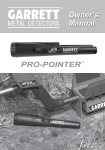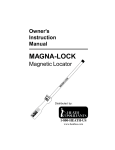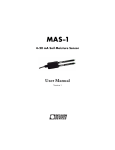Download Application Note Comparing Eddy Current and Magnetic
Transcript
Application Note Comparing Eddy Current and Magnetic Measurement Methods Eddy Current Advantages: Eddy current probes have more versatile measurement capabilities than magnetic probes, because eddy current probes measure non-conductive on non-magnetic, metallic on nonferrous, and non-magnetic on ferrous. Eddy current is better for small parts or rough surfaces. Eddy current probes are less susceptible to edge effects and topography than magnetic probes. It should still be compensated for in the calibration set up. See application note titled “Factors Affecting Accuracy and Repeatability of Eddy Current and Magnetic Measurements” and user manual. Eddy Current Disadvantages: Requires standards that are have the same electrical properties as the coated substrate you will measure. So for greatest accuracy of metal on ferrous you need standards with coatings and bases that are electrically identical to the coating/base being measured. The calibration sample can have different electrical properties than you can compensate for with a Conductivity Factor (See below). Magnetic Advantages: For measuring non-magnetic and non-conductive coatings on iron. Requires fewer standards (just plastic shims) for all non-magnetic/conductive coatings applied to an iron base. For greatest accuracy the calibration base should have the same magnetic properties as the coated base. Magnetic Disadvantage: A magnetic probe will only work when the base is magnetic (i.e. base = iron, nickel or cobalt) and the coating is non-magnetic and vice verse. Eddy Current Measurement Accuracy of Metallic Coatings: When measuring metallic coatings with the eddy current method, it is important that the conductive properties of the standards (plating and base) be identical to that of the samples being measured. When measuring zinc, one must use zinc-plated standards. You can’t use copper plated because the conductivities of zinc and copper are significantly different. Conductivity of the plating is dependent on the material, the density, grain or crystal structure and even inclusions or contaminants in the coating itself. If you are measuring plated material that was done in an acid chloride bath, then the calibration standards should be also from an acid chloride bath. If you know that it measures off by the same ratio repeatedly (for example, it always measures 90% of the true value. ), you can create a calibration with a Conductivity Factor. 1. So you measured .09 µm but you know the actual value is .1 µm. The measurement is only 90% (.09/.1=.9=90%) of the actual value. 2. The multiplier will always be 1/ (measured/actual value). To determine the multiplier for this example, divide 1/(.09/.1) = 1.11 Rev. A Page 1 of 2 Application Note Comparing Eddy Current and Magnetic Measurement Methods 3. Then the gage will read .09 and multiply it by 1.11 and it will display .099. Now the reading is only off by 1%. If calibration sample has a different topography/base properties than the sample measured, you can compensate using an offset. Refer to application note titled “Factors Affecting Accuracy and Repeatability of Eddy Current and Magnetic Measurements” and user manual. Question: What is the best method for measuring zinc and cadmium on steels? Answer: Either (it’s relative). Both methods provide the same accuracy and repeatability. Accuracy is based upon the calibration set up. Refer to application note titled “Factors Affecting Accuracy and Repeatability of Eddy Current and Magnetic Measurements” and user manual. Rev. A Page 2 of 2








